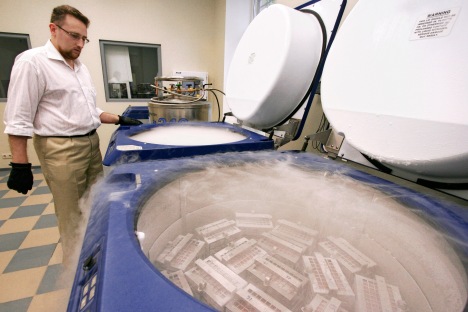
These results put Siberian researchers firmly at the top of their field. Source: Kommersant
So what exactly have Siberian researchers come up with that is so ground breaking? Their work is based on the remarkable ability of stem cells to differentiate into different cell types.
Every cell follows an individual transformation pattern, its chain of metamorphoses being triggered by special "commands" from the organism.
These signals are yet to be discovered and described in their entirety by modern science, but researchers seem to have figured out the ones that the nervous system sends.
Today, scientists can send chemical signals to stem cells that trigger their transformation into nervous system cells, primarily neurons, which carry electrical signals to muscles, glands, the skin and mucous membranes.
“We have experimented on animals with complete spinal cord lacerations,” explains Krasnoyarsk State Medical University professor and decorated medical pioneer, Igor Bolshakov.
“They were completely paralyzed, but recovered mobility after we grafted our stem cell matrices onto their spines. Their pelvic organs – the bladder, rectum etc. – also regained full function.”
In fact, the world’s leading research laboratories have been able to turn stem cells into spinal cord cells in vitro, but, as is often the case in science, the method, which is pretty well known, hasn’t been easy to put into practice.
According to Bolshakov, his Russian and foreign colleagues have so far failed to carry out successful transplants because they take newly transformed stem cells off their matrix to graft them onto injured areas of the spine, killing or deactivating the vulnerable cells in transit.
Siberian researchers start studying H7N9 flu strain
“But we have developed a way to transfer the cells with the matrix without taking them off their 'incubator,'” Bolshakov says. “That minimizes our cell losses and allows us to almost completely restore spinal cords function, enabling animals to move again.”
These results put Siberian researchers firmly at the top of their field. But so far, they have only carried out experiment on animals.
To perform these surgeries on humans, Bolshakov’s team will need better equipment and materials, which means better financing. According to Bolshakov, while the benefits of this revolutionary technology are quite obvious, a number of legal issues related to stem cell use may stymie its implementation.
(“Rise up and walk” is a quote from Luke 5:17-26 – Ed.)
All rights reserved by Rossiyskaya Gazeta.
Subscribe
to our newsletter!
Get the week's best stories straight to your inbox